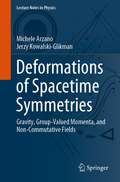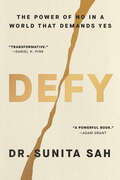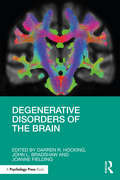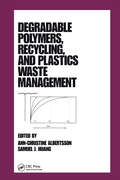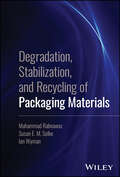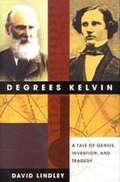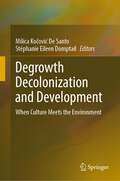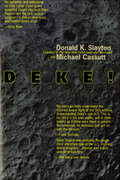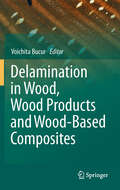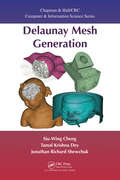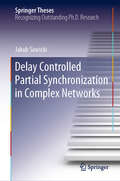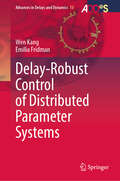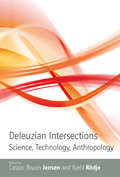- Table View
- List View
Deformations of Spacetime Symmetries: Gravity, Group-Valued Momenta, and Non-Commutative Fields (Lecture Notes in Physics #986)
by Michele Arzano Jerzy Kowalski-GlikmanThis monograph provides an introduction to deformations of Poincaré symmetries focusing on models with a Lie group momentum space and associated non-commutative space-times. The emphasis is put on the emergence of such structures from quantum gravity, their mathematical features described in terms of Hopf algebras and applications to particle kinematics and field theory. Part I of this work focuses on the link between gravity and deformed symmetries in the case of 2+1 and 3+1 space-time dimensions. Part II is devoted to the description of classical particles with group valued momenta, their phase spaces and kinematics. The last part of these notes provides an introduction to the basic features of classical and quantum field theory on κ-Minkowski space-time, the prototypical example of non-commutative space-time exhibiting deformed Poincaré symmetry. The text, being the first providing a detailed overview of these topics, is primarily intended for researchers and graduate students interested in non-commutative field theories and quantum gravity phenomenology.
Defrosting Ancient Microbes: Emerging Genomes in a Warmer World
by John D. Castello Scott RogersIce is melting around the world and glaciers are disappearing. Water, which has been solid for thousands and even millions of years, is being released into streams, rivers, lakes and oceans. Embedded in this new fluid water, and now being released, are ancient microbes whose effects on today's organisms and ecosystems is unknown and unpredictable. These long sleeping microbes are becoming physiologically active and may accelerate global climate change. This book explores the emergence of these microbes. The implications for terrestrial life and the life that might exist elsewhere in the universe are explored. Key Selling Points: Explores the role of long frozen ancient microbes will have when released due to global warming Describes how ice preserves microbes and microbial genomes for thousands or millions of years Reviews work done on permafrost microbiology Identifies potential health hazards and environmental risks Examines implications for the search for extraterrestrial life.
Defy: The Power of No in a World That Demands Yes
by Dr. Sunita SahWhy is it so hard to speak up, even when we know something&’s wrong?This is the definitive book on defiance, a clear-eyed dissection of the forces that silence us, featuring groundbreaking research and legendary stories alongside everyday examples and strategies for how to unleash the power of a &“True No.&”Many of us comply much more than we realize. How many times have you wanted to object, disagree, or opt out of something but ended up swallowing your words, shaking your head, and just going along? Analyzing cases ranging from corporate corruption and sexual abuse to everyday acquiescence at work, the doctor&’s office, and in our personal lives, award-winning organizational psychologist Dr. Sunita Sah delves deep into why the pressure to comply is a corrosive and often invisible force in our society.With her own revelatory research, she radically transforms our idea of defiance from a misunderstood negative trait into a crucial, positive force for personal and societal change. Taking us through her five stages of defiance, Dr. Sah equips readers with simple tools to make decisions that align with their values. Defy is the essential playbook for how to speak up and act when it matters most.
Defying Limits: Lessons from the Edge of the Universe
by Dave WilliamsAn inspirational, uplifting, and life-affirming memoir about passion, resilience and living life to the fullest, from Dr. Dave Williams, one of Canada’s most accomplished astronauts.I had dreamt about becoming an astronaut from the time I watched Alan Shepard launch on the first American sub-orbital flight on May 5, 1961. Eleven days before my seventh birthday, I committed to a new goal: one day, I would fly in outer space. Dr. Dave has led the sort of life that most people only dream of. He has set records for spacewalking. He has lived undersea for weeks at a time. He has saved lives as an emergency doctor, launched into the stratosphere twice, and performed surgery in zero gravity. But if you ask him how he became so accomplished, he’ll say: “I’m just a curious kid from Saskatchewan.” Curious indeed. Dr. Dave never lost his desire to explore nor his fascination with the world. Whether he was exploring the woods behind his childhood home or floating in space at the end of the Canadarm, Dave tried to see every moment of his life as filled with beauty and meaning. He learned to scuba dive at only twelve years old, became a doctor despite academic struggles as an undergraduate, and overcame stiff odds and fierce competition to join the ranks of the astronauts he had idolized as a child. There were setbacks and challenges along the way—the loss of friends in the Columbia disaster, a cancer diagnosis that nearly prevented him from returning to space—but through it all, Dave never lost sight of his goal. And when he finally had the chance to fly among the stars, he came to realize that although the destination can be spectacular, it’s the journey that truly matters. In Defying Limits, Dave shares the events that have defined his life, showing us that whether we’re gravity-defying astronauts or earth-bound terrestrials, we can all live an infinite, fulfilled life by relishing the value and importance of each moment. The greatest fear that we all face is not the fear of dying, but the fear of never having lived. Each of us is greater than we believe. And, together, we can exceed our limits to soar farther and higher than we ever imagined.
Degenerate Diffusion Operators Arising in Population Biology (Annals of Mathematics Studies #185)
by Charles L. Epstein Rafe MazzeoThis book provides the mathematical foundations for the analysis of a class of degenerate elliptic operators defined on manifolds with corners, which arise in a variety of applications such as population genetics, mathematical finance, and economics. The results discussed in this book prove the uniqueness of the solution to the Martingale problem and therefore the existence of the associated Markov process. Charles Epstein and Rafe Mazzeo use an "integral kernel method" to develop mathematical foundations for the study of such degenerate elliptic operators and the stochastic processes they define. The precise nature of the degeneracies of the principal symbol for these operators leads to solutions of the parabolic and elliptic problems that display novel regularity properties. Dually, the adjoint operator allows for rather dramatic singularities, such as measures supported on high codimensional strata of the boundary. Epstein and Mazzeo establish the uniqueness, existence, and sharp regularity properties for solutions to the homogeneous and inhomogeneous heat equations, as well as a complete analysis of the resolvent operator acting on Hölder spaces. They show that the semigroups defined by these operators have holomorphic extensions to the right half-plane. Epstein and Mazzeo also demonstrate precise asymptotic results for the long-time behavior of solutions to both the forward and backward Kolmogorov equations.
Degeneration and Regeneration in the Nervous System
by N. R. Saunders K. M. DziegielewskaDegeneration and Regeneration in the Nervous System brings together an international team of contributors to produce a series of critical reviews appraising key papers in the field. The pace of research on brain and spinal cord injury quickened considerably in the last ten years and there is much that is new and important that is covered in this bo
Degenerative Disorders of the Brain
by John L. Bradshaw Darren R. Hocking Joanne FieldingCovering a wide range of diverse age-related disorders, Degenerative Disorders of the Brain addresses disabilities that occur or have their roots in the later stages of life. The book brings together an internationally recognised group of contributors to discuss frontostriatal, fronto-cerebellar and other major brain systems and structures which control and direct normal behaviour, and which can fail during the aging process, as well as addressing behavioural, clinical, pathophysiological and technical aspects. Discussing the latest clinical and behavioural findings of disorders which are largely, though not necessarily entirely, age related, including Alzheimer’s disease and other dementias, Parkinson’s disease and related disorders, and Huntington’s disease, the book covers information vital to the understanding, diagnosis, and management of degenerative disorders of the brain. It also considers the role of epigenetics, neural plasticity, and environmental enrichment in neurodegenerative disorders alongside the role of ground-breaking intervention methods, including transcranial magnetic stimulation and deep brain stimulation. Degenerative Disorders of the Brain will be of great interest to, and use for, clinicians, researchers, students, lecturers, and affected individuals and their relatives.
Degradable Polymers, Recycling, and Plastics Waste Management
by AlbertssonBased on the International Workshop on Controlled Life-Cycle of Polymeric Materials held in Stockholm, this work examines degradable polymers and the recycling of plastic materials. It highlights recent results on recycling and waste management, including topics such as renewable resources, degradation, processing and products, and environmental is
Degradation of Bioactive Substances: Physiology and Pathophysiology
by Jens H. HenriksenIntended primarily for researchers working with bioactive substances such as hormones, neurotransmitters, growth factors, and connective tissue makers, this book discusses the principles of degradation in major groups of bioactive materials with respect to physiology, location, and regulation. Peptidases; receptor-mediated endocytosis; organ extraction and clearance; and the degradation of specific proteins, peptides, amines, steroids, and polysaccharoides are featured. Pathophysiology and its role in diagnostics and disease are considered throughout the book, in addition to updates of recent literature and substantial new information on physiology and pathophysiology of degradation of bioactive material. No special mathematical or kinetic background is necessary to read this book because the mathematic and kinetic concepts are facilitated through the presentation of fundamental and more advanced principles. Furthermore, illustrations and tables are provided to facilitate the understanding of the dynamic aspects of degradation processes. Degradation of Bioactive Substances: Physiology and Pathophysiology is the first comprehensive work describing the degradation of bioactive material, including information not found in biochemical textbooks on internal metabolism or pharmacokinetic textbooks on drug metabolism.
Degradation of Implant Materials
by Noam EliazThis book reviews the current understanding of the mechanical, chemical and biological processes that are responsible for the degradation of a variety of implant materials. All 18 chapters will be written by internationally renowned experts to address both fundamental and practical aspects of research into the field. Different failure mechanisms such as corrosion, fatigue, and wear will be reviewed, together with experimental techniques for monitoring them, either in vitro or in vivo. Procedures for implant retrieval and analysis will be presented. A variety of biomaterials (stainless steels, titanium and its alloys, nitinol, magnesium alloys, polyethylene, biodegradable polymers, silicone gel, hydrogels, calcium phosphates) and medical devices (orthopedic and dental implants, stents, heart valves, breast implants) will be analyzed in detail. The book will serve as a broad reference source for graduate students and researchers studying biomedicine, corrosion, surface science, and electrochemistry.
Degradation, Stabilization, and Recycling of Packaging Materials
by Susan E. Selke Muhammad Rabnawaz Ian WymanPractical guidance to sustainable packaging and its challenges with analysis of various packaging materials and their interactions with different environments Degradation, Stabilization, and Recycling of Packaging Materials analyzes packaging materials and their interactions with different environments, discussing the degradation processes of different materials like plastics, wood, paper, glass, and metal, providing specific strategies to address these degradation processes, and exploring solid waste management, recent developments in recycling, and the principles of eco-friendly packaging design. Organized into two parts, the first section of this book provides a comprehensive examination of how environmental factors such as heat, shear, light, air, packaged products, and stress affect packaging materials, focusing on the chemistry of their deterioration and stabilization methods. The second section explores solid waste management, recent developments in recycling, and key principles of eco-friendly packaging design, culminating in an extensive discussion of legal and regulatory aspects. The book includes case studies and problem sets in each chapter, with solutions to the problems in an appendix in the back of the book. Written by a team of highly qualified authors, Degradation, Stabilization, and Recycling of Packaging Materials includes discussion on: Structure of tinplate and tin-free steel, corrosion in lacquered cans, and effects of producing, processing, and storing metalsRecyclable versus repulpable paper, uses of recycled papers, wet-strength papers, non-wood fibers as paper sources, and contamination issues with paper recyclingPlastic recycling rates, plastic scrap exports in the US and abroad, chemical versus mechanical plastic recycling, hydrocracking of plastics, and PE and PET recyclingLightweight glass bottles, strategies to modify or strengthen glass, and the real recyclability of glass Presenting advanced technical knowledge that demystifies the sustainable packaging landscape Degradation, Stabilization, and Recycling of Packaging Materials is a critical resource for researchers, students, and industry professionals in the field of materials science and packaging to evaluate challenges related to solid waste and devise effective disposal strategies.
Degrading Enzymes for Marine Polysaccharides and Their Applications
by Xiangzhao MaoThis book provides a comprehensive overview of degrading enzymes specific to marine polysaccharides and explores their wide-ranging applications. It offers in-depth coverage of the structure, sources, physicochemical properties, and bioactivities of marine polysaccharides and oligosaccharides, along with advanced tools for enzyme mining, expression, and modification. By compiling recent findings and methodologies, the book serves as a valuable resource for researchers and professionals in biotechnology, marine biology, and biochemistry seeking to explore enzymatic applications in food, pharmaceutical, and environmental fields.
Degrees Kelvin: A Tale Of Genius, Invention, And Tragedy
by David LindleyLORD KELVIN. In 1840, a precocious 16-year-old by the name of William Thomson spent his summer vacation studying an extraordinarily sophisticated mathematical controversy. His brilliant analysis inspired lavish praise and made the boy an instant intellectual celebrity. <P> As a young scholar William dazzled a Victorian society enthralled with the seductive authority and powerful beauty of scientific discovery. At a time when no one really understood heat, light, electricity, or magnetism, Thomson found key connections between them, laying the groundwork for two of the cornerstones of 19th century science -- the theories of electromagnetism and thermodynamics. Charismatic, confident, and boyishly handsome, Thomson was not a scientist who labored quietly in a lab, plying his trade in monkish isolation. When scores of able tinkerers were flummoxed by their inability to adapt overland telegraphic cables to underwater, intercontinental use, Thomson took to the high seas with new equipment that was to change the face of modern communications. And as the world's navies were transitioning from wooden to iron ships, they looked to Thomson to devise a compass that would hold true even when surrounded by steel. <P> Gaining fame and wealth through his inventive genius, Thomson was elevated to the peerage by Queen Victoria for his many achievements. He was the first scientist ever to be so honored. Indeed, his name survives in the designation of degrees Kelvin, the temperature scale that begins with absolute zero, the point at which atomic motion ceases and there is a complete absence of heat. <P> Sir William Thomson, Lord Kelvin, was Great Britain's unrivaled scientific hero. But as the century drew to a close and Queen Victoria's reign ended, this legendary scientific mind began to weaken. He grudgingly gave way to others with a keener, more modern vision. But the great physicist did not go quietly. With a ready pulpit at his disposal, he publicly proclaimed his doubts over the existence of atoms. He refused to believe that radioactivity involved the transmutation of elements. And believing that the origin of life was a matter beyond the expertise of science and better left to theologians, he vehemently opposed the doctrines of evolution, repeatedly railing against Charles Darwin. Sadly, this pioneer of modern science spent his waning years arguing that the Earth and the Sun could not be more than 100 million years old. And although his early mathematical prowess had transformed our understanding of the forces of nature, he would never truly accept the revolutionary changes he had helped bring about, and it was others who took his ideas to their logical conclusion. <P> In the end Thomson came to stand for all that was old and complacent in the world of 19th century science. Once a scientific force to be reckoned with, a leader to whom others eagerly looked for answers, his peers in the end left him behind -- and then meted out the ultimate punishment for not being able to keep step with them. For while they were content to bury him in Westminster Abbey alongside Isaac Newton, they used his death as an opportunity to write him out of the scientific record, effectively denying him his place in history. Kelvin's name soon faded from the headlines, his seminal ideas forgotten, his crucial contributions overshadowed. Destined to become the definitive biography of one of the most important figures in modern science, Degrees Kelvin unravels the mystery of a life composed of equal parts triumph and tragedy, hubris and humility, yielding a surprising and compelling portrait of a complex and enigmatic man.
Degrowth Decolonization and Development: When Culture Meets the Environment
by Milica Kočović De Santo Stéphanie Eileen DomptailDegrowth Decolonization and Development reveals common underlying cultural roots to the multiple current crises. It shows that culture is an essential sphere to initiate fundamental changes and solutions as it brings about transformative imaginaries on a theoretical, political and practical level. The book focusses on the interplay between culture and the environment, society and the economy. It provides a critique of concepts associated with the term “Development” and reveals knowledge and theories outside the comfort zone of the mainstream Western theoretical landscape, which will certainly be instrumental in the decolonization of both development theories and practices. The book convincingly reveals the large array of domains, which, when interpreted from a decolonization and Degrowth perspective, can be managed through logics of environmental justice, social equity and equality, and generate societally more desirable outcomes. The book presents a multidisciplinary perspective on the contemporary global crises and features interdisciplinary analyses thereof through the lenses of cultural studies, critical development studies, political economy, eco-feminist political ecology, anthropology and sociology. Degrowth Decolonization and Development unveils the fundamental role of the dichotomies characterizing the Western modern development paradigm in shaping today’s actions, and especially the dichotomies of Global North and Global South, Centre and Periphery, Developed and Developing/Underdeveloped, Man and Nature. Degrowth Decolonization and Development addresses all researchers and activists interested in sustainability transformation and decolonization processes in Development studies. Degrowth Decolonization and Development is structured as a collection of seven original case studies. These are authored by researchers who met when presenting their work in Decolonization and Degrowth panels from the ISEE-ESEE-Degrowth Conference, Manchester, July 5-8, 2021, and the 8th International Degrowth Conference in The Hague, Netherlands, August 24-28, 2021. The concluding chapter proposes a synthesis identifying key concepts and steps in cultural change for the decolonization of the Western worldview towards “pluriverse” alternatives. The book traces future imaginaries for modelling future new systemic solutions and a needed radical change.
Dehydrogenation Reactions with 3d Metals (Topics in Organometallic Chemistry #73)
by Basker SundararajuIn this book recent developments in dehydrogenation reactions catalyzed by 3d-metals are discussed. With continue efforts to develop sustainable chemical production the discovery of new catalysts and catalytic procedures for (de)hydrogenation reactions are a subject of great interest to the chemistry community. Additionally, (de)hydrogenation reactions enable the creation of closed-loop production cycles that support a circular economy. The chapters presented include the synthesis of heterocycles and tandem-multicomponent (three or more) reactions through dehydrogenative strategy, as well as the conversion of ethanol to n-butanol, higher oxidized hydrocarbons like acids, ester, amides from alcohols, α-alkylation of amines, ketones, and amides with alcohols and mechanistic understanding of dehydrogenation reactions with high-valent metals. With contributions from experts in the field, the book is a valuable resource for scholars working in the field of organometallic chemistry, catalysis, medicinal chemistry, as well as researchers in the industry.
Deke!: From Mercury To The Shuttle
by Michael Cassutt Donald K. SlaytonDeke Slayton was one of the first seven Mercury astronauts--and he might have been the first American in space. Instead, he became the first chief of American Astronaut Corps. It was Deke Slayton who selected the crews who flew the Gemini, Apollo, and Skylab missions. It was Deke Slayton who made Neil Armstrong the first man on the moon.Deke! is Deke Slayton's' story--told in his own words and in the voices of the men and women who worked with him and knew him best. Deke Slayton's knowledge of how the .S. manned space program worked is the missing piece of every space buff's puzzle. Now, after decades of silence, he tells his priceless stories of those years when American was engaged in the greatest voyage of exploration in human history.At the Publisher's request, this title is being sold without Digital Rights Management Software (DRM) applied.
Delamination in Wood, Wood Products and Wood-Based Composites
by Voichita BucurIn the last quarter century, delamination has come to mean more than just a failure in adhesion between layers of bonded composite plies that might affect their load-bearing capacity. Ever-increasing computer power has meant that we can now detect and analyze delamination between, for example, cell walls in solid wood. This fast-moving and critically important field of study is covered in a book that provides everyone from manufacturers to research scientists the state of the art in wood delamination studies. Divided into three sections, the book first details the general aspects of the subject, from basic information including terminology, to the theoretical basis for the evaluation of delamination. A settled terminology in this subject area is a first key goal of the book, as the terms which describe delamination in wood and wood-based composites are numerous and often confusing. The second section examines different and highly specialized methods for delamination detection such as confocal laser scanning microscopy, light microscopy, scanning electron microscopy and ultrasonics. Ways in which NDE (non-destructive evaluation) can be employed to detect and locate defects are also covered. The book's final section focuses on the practical aspects of this defect in a wide range of wood products covering the spectrum from trees, logs, laminated panels and glued laminated timbers to parquet floors. Intended as a primary reference, this book covers everything from the microscopic, anatomical level of delamination within solid wood sections to an examination of the interface of wood and its surface coatings. It provides readers with the perspective of industry as well as laboratory and is thus a highly practical sourcebook for wood engineers working in manufacturing as well as a comprehensively referenced text for materials scientists wrestling with the theory underlying the subject.
Delaunay Mesh Generation (Chapman & Hall/CRC Computer and Information Science Series)
by Siu-Wing Cheng Tamal K. Dey Jonathan ShewchukWritten by authors at the forefront of modern algorithms research, Delaunay Mesh Generation demonstrates the power and versatility of Delaunay meshers in tackling complex geometric domains ranging from polyhedra with internal boundaries to piecewise smooth surfaces. Covering both volume and surface meshes, the authors fully explain how and why thes
Delay Controlled Partial Synchronization in Complex Networks (Springer Theses)
by Jakub SawickiThe focus of this thesis are synchronization phenomena in networks and their intrinsic control through time delay, which is ubiquitous in real-world systems ranging from physics and acoustics to neuroscience and engineering. We encounter synchronization everywhere and it can be either a helpful or a detrimental mechanism. In the first part, after a survey of complex nonlinear systems and networks, we show that a seemingly simple system of two organ pipes gives birth to complex bifurcation and synchronization scenarios. Going from a 2-oscillator system to a ring of oscillators, we encounter the intriguing phenomenon of chimera states which are partial synchrony patterns with coexisting domains of synchronized and desynchronized dynamics. For more than a decade scientist have tried to solve the puzzle of this spontaneous symmetry-breaking emerging in networks of identical elements. We provide an analysis of initial conditions and extend our model by the addition of time delay and fractal connectivities. In the second part, we investigate partial synchronization patterns in a neuronal network and explain dynamical asymmetry arising from the hemispheric structure of the human brain. A particular focus is on the novel scenario of partial relay synchronization in multiplex networks. Such networks allow for synchronization of the coherent domains of chimera states via a remote layer, whereas the incoherent domains remain desynchronized. The theoretical framework is demonstrated with different generic models.
Delay-Coupled Complex Systems
by Valentin FlunkertThis work addresses time-delay in complex nonlinear systems and, in particular, its applications in complex networks; its role in control theory and nonlinear optics are also investigated. Delays arise naturally in networks of coupled systems due to finite signal propagation speeds and are thus a key issue in many areas of physics, biology, medicine, and technology. Synchronization phenomena in these networks play an important role, e.g., in the context of learning, cognitive and pathological states in the brain, for secure communication with chaotic lasers or for gene regulation. The thesis includes both novel results on the control of complex dynamics by time-delayed feedback and fundamental new insights into the interplay of delay and synchronization. One of the most interesting results here is a solution to the problem of complete synchronization in general networks with large coupling delay, i.e., large distances between the nodes, by giving a universal classification of networks that has a wide range of interdisciplinary applications.
Delay-Robust Control of Distributed Parameter Systems (Advances in Delays and Dynamics #13)
by Emilia Fridman Wen KangThis monograph examines stability in complex distributed parameter systems using advanced robust control methods. It presents Lyapunov-based conditions in the form of linear matrix inequalities to establish the stability analysis for the case of constrained control, sampled-data control, event-triggered control, and disturbance rejection control. The book offers innovative strategies to tackle issues related to nonlinearity, uncertainties, and delays. The theoretical contributions of this work are significant, providing valuable insights that extend beyond academic theory into practical engineering applications. The methods discussed are poised to influence real-world problem-solving in this field. The insights and methods presented will be invaluable to both researchers and practitioners, offering a deeper understanding of the impacts of time delays and advanced control techniques.
Delays and Interconnections: Methodology, Algorithms and Applications (Advances in Delays and Dynamics #10)
by Alexandre Seuret Islam Boussaada Rifat Sipahi Giorgio ValmorbidaThis book contains advances on the theory and applications of time-delay systems with particular focus on interconnected systems. The methods for stability analysis and control design are based on time-domain and frequency-domain approaches, for continuous-time and sampled-data systems, linear and nonlinear systems. This volume is a valuable source of reference for control practitioners, graduate students, and scientists researching practical as well as theoretical solutions to a variety of control problems inevitably influenced by the presence of time delays. The contents are organized in three parts: Interconnected Systems analysis, Modeling and and Analysis for Delay systems, and Stabilization and Control Strategies for Delay Systems. This volume presents a selection of 19 contributions presented in the 4th DelSys Workshop which took place in Gif-sur-Yvette, France November 25-27, 2015.
Deleuze And Anarchism (Deleuze Connections)
by Aragorn Eloff Chantelle HeerdenExplores Deleuze and Guattari's own diverse conceptions of anarchism and expands it in the spirit of their philosophy <p><p> This collection of 13 essays addresses and explores Deleuze and Guattari's relationship to the notion of anarchism: in the diverse ways that they conceived of and referred to it throughout their work, and also more broadly in terms of the spirit of their philosophy and in their critique of capitalism and the State. <p> Both Deleuze and Guattari were deeply affected by the events of May '68 and an anarchist sensibility permeates their philosophy. However, they never explicitly sustained a discussion of anarchism in their work. Their concept of anarchism is diverse and they referred to in very different senses throughout their writings. This is the first collection to bring Deleuze and Guattari together with anarchism in a focused and sustained way.
Deleuze and the Non/Human
by Jon Roffe Hannah StarkDeleuze and the Non/Human brings together leading international voices to consider the place of the philosophy of Gilles Deleuze in the nonhuman turn. It examines recent debates about the figure of the nonhuman in fields such as new materialism, speculative realism, animal studies, and the environmental and ecological Humanities and scrutinizes the debt to Deleuze's work that is evident in these emerging fields. Accordingly, the contributors to the volume are drawn from across the academy. Deleuze's philosophy already anticipated many of the current debates about the non/human. The proposed volume continues this engagement, extending some of these lines of investigation, in disciplines such architecture, literary studies, gender studies, philosophy, geography and cultural studies. At the same time, its goal is to open up a critical line of questioning about what the nonhuman means in Deleuze's work itself. Deleuze and the Non/Human is thus both about the non/human from Deleuze's point of view, and about Deleuze from the point of view of the various problematics that can be included in the nonhuman turn. Deleuze and the Non/Human makes a timely intervention in a broad set of interdisciplinary debates, and demonstrates once again the force of Deleuze's philosophy for our critical examination of the contemporary condition.
Deleuzian Intersections
by Casper Bruun Jensen Kjetil RodjeScience and technology studies, cultural anthropology and cultural studies deal with the complex relations between material, symbolic, technical and political practices. In a Deleuzian approach these relations are seen as produced in heterogeneous assemblages, moving across distinctions such as the human and non-human or the material and ideal. This volume outlines a Deleuzian approach to analyzing science, culture and politics.
